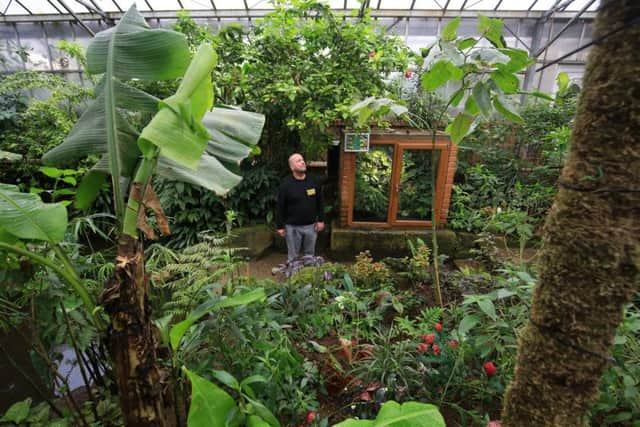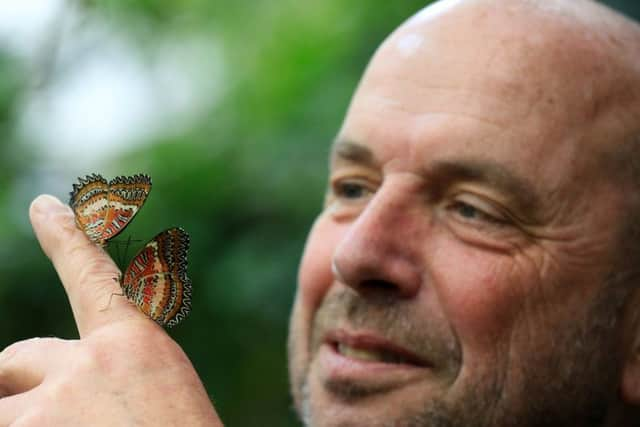Encounters with the exotic: South Yorkshire Tropical Butterfly House marks 25 years
Tucked away in a corner of South Yorkshire, down a lane past rows of everyday houses, lives a menagerie of extraordinary animals.
Exotic, vibrantly-coloured insects, rare bats, cheerful birds and fascinating reptiles all await visitors to the Tropical Butterfly House, Wildlife and Falconry Centre in North Anston, heading towards Worksop 15 miles from the middle of Sheffield.
Advertisement
Hide AdAdvertisement
Hide AdAnd they’re a popular attraction - so popular, it transpires, that there are many days when extra guests simply can’t be accommodated.


“In the last eight years we’ve gone from 80,000 to 150,000 visitors a year,” says Andrew Reeve, park manager at the Butterfly House which marks its 25th anniversary this Saturday. “At normal busy times we can’t cater for any more people, we haven’t got the parking or anything like that. The peak period now is really February ‘til October - November, December, January is quietish, then we’re full to capacity most days.”
There is an ongoing drive, he says, to manage crowds at the site, which doubled in size to eight acres half a decade ago.
“We’re trying to encourage people to come in quieter times now. It’s not easy to achieve. If it’s a sunny day, everyone comes out, don’t they? Over the February half term every zoo I spoke to was rammed. At Twycross they turned people away.”
Advertisement
Hide AdAdvertisement
Hide AdMaybe, he speculates, there is an appetite for hands-on experiences in a world so often mediated by technology.


“What we’re aiming to do is empower the age group we get coming into the park to be passionate about wildlife in the future. In this day and age, everyone’s on the internet so they don’t really interact like we did when I was a kid. You were chucked out in a field and left to it all day.”
Andrew’s own passion for nature began when he was a child growing up in Harpenden, Hertfordshire.
“As a little boy I kept crocodiles in my bedroom. Of course, now you have to have a dangerous wild animal licence. The biggest one was five feet long, it used to sleep in my bedroom in a big metal bath. Crocodiles have always been a bit of a thing for me. I can’t explain why, I just find them fascinating.”
He was never bitten, he proudly points out.
Advertisement
Hide AdAdvertisement
Hide Ad“I always think if you’ve been bitten by something you don’t know what you’re doing, because you haven’t given them enough respect.”
He trained birds too, but had completely a different day job working for British Gas before being headhunted by Whipsnade, the UK’s biggest zoo, in 1990.
“The problem was money, because I had kids when I was young. They matched what I was earning and I just did really well there.”
He helped to set up a new zoo at Pensthorpe in Norfolk, and acted as a consultant at the Butterfly House before being hired full-time.
Advertisement
Hide AdAdvertisement
Hide AdThe place is unique, he believes. “I like the fact it’s all hands-on. The bigger zoos drifted away from it but I think they’re now getting back into it because they realise how important it is, to actually touch something.”
Tactile opportunities are many and varied. With a little gentle coaxing, the centre’s different varieties of butterfly, from burnished orange monarchs to beautiful blue morphos from Costa Rica, will sit on a visitor’s finger, while people are allowed to go inside the lemur enclosure for close encounters with the curious but well-behaved primates.
Andrew demonstrates by picking up a tenrec, a small, spiny animal from Madagascar that ‘looks like a hedgehog but isn’t’. “Its closest relative is the elephant. We use these for teaching people about where evolution varies.”
The butterfly house itself, a glazed structure kept heated to a humid rainforest temperature, was where the attraction started off. It was the idea of Bob Bellis, a builder by trade with an enthusiasm for bugs and plants.
Advertisement
Hide AdAdvertisement
Hide Ad“He’s a naturalist, really,” says Andrew. “He’s an interesting person, he knows what the public wants to see, but he’s not a public person. He liked going catching butterflies in the summer months, but there were none in winter so he built the tropical house.”
It was a ‘high risk thing for him to do’, Andrew reflects. “He had to borrow money every year to get it established.”
Butterfly pupa are bought in batches of 400 every two weeks from sustainable breeding farms in Costa Rica and the Phillipines. They are hatched in a glass-fronted cupboard and are then allowed to flap around freely, making the most of their brief lifespan.
There is much to spot inside the house - four fruit bats from the Rodrigues island east of Mauritius, for example, and an imperious-looking iguana that dwells amid the ferns, umbrella plants and other greenery.
Advertisement
Hide AdAdvertisement
Hide Ad“It’s all changed from when I first started,” says Andrew. “What zoos do these days is manage species for breeding, basically. That’s the main aim and objective, to try and hold a population that maybe we can use for the wild in future.”
Zoos, he emphasises, have ‘stepped up to the mark’. “To have a licence we have to prove we do conservation work.”
Money is raised for numerous causes including projects for tenrecs, vultures, parrots and lemurs, which are the focus of a group that calls for people to stop killing them for food. The site is also home to the largest tree sparrow population in the UK.
“I don’t think we did it very well 20 years ago,” says Andrew. “We’re looking after the welfare of things a lot better.”
Advertisement
Hide AdAdvertisement
Hide AdThe centre’s general audience is under-10s, but other age groups are welcome.
“Mornings are very popular with young children and their parents - then when they drift off at two o’clock we’re trying to encourage older people to come and have a nice chill-out,” says Andrew. “Once all the schoolkids have gone this is like a little paradise. We’ve just got to get that message across.”
Bob, meanwhile, is handing over the role of chief executive to his daughter Kim. He has bought three sites elsewhere in the last three years that he plans to manage privately for native species, including butterflies.
“He’s always put everything back into the park,” says Andrew. “He doesn’t drive a fancy car or anything like that.”
Advertisement
Hide AdAdvertisement
Hide AdAndrew, 60, lives between Newark and Lincoln, and keeps a small zoo at home with bald eagles, goshawks, sparrowhawks, snakes and the like. “No crocodiles at the minute. Maybe when I retire I’ll keep them again.”
Working with animals on a day-to-day basis is, he says, ‘the best job in the world’. “I’m very lucky to be able to be part of it.”
And will the Butterfly House still be around in another 25 years? “Yeah, definitely.”
Celebrations for the 25th anniversary will start on Saturday with a birthday cake for the animals, and family activities.